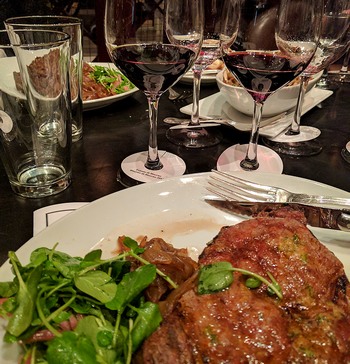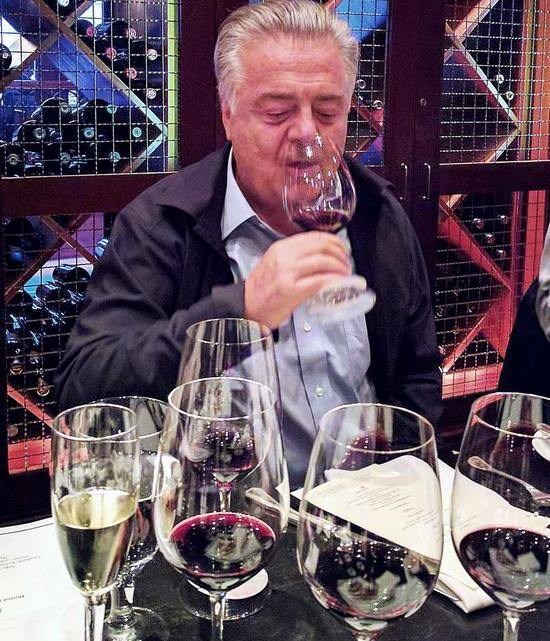As a young man, the Marchese Lodovico Antinori (above) helped revolutionize Italian winemaking with his Bordeaux-blend powerhouse wines from Ornellaia. But he had more surprises in store. After selling Ornellaia, he became intrigued about the potential for Cabernet Franc in the region around Bolghieri. So he acquired a 99-year lease on land that had been growing wheat and olives in nearby Bibbona. Here, he and his brother Piero, established the Tenuta di Biserno estate (www.biserno.it/tenuta-di-biserno/).
The unique microclimate and mixture of clay and stony soils at the property let the brothers concentrate on different Bordeaux varietals than Lodovico had at Ornellaia. Between 2001 and 2005, the Tenuta di Biserno planted more than 120 acres. Cabernet Franc was the principal grape, but more than 10 percent of the vineyards contained Petit Verdot, the often silent sister of the Bordeaux grape family. Merlot and Cabernet Sauvignon—usually the dominant grapes in Bordeaux blends—made up the rest.
“My daughter Sophia was was born in 1999,” Lodovico Antinori explained last week at a dinner in Boston. “For my last project, I wanted her to have a high quality estate that she could continue.” We guess that people who hail from illustrious wine families think in generations and centuries. As Sophia enters college in England, Tenuta di Biserno is also maturing. It already ranks as one of the most remarkable wine estates in Tuscany, even though the wines are identified by only as Indicazione Geografica Tipica di Toscana, or “guaranteed Tuscan wine.” Tenuta di Biserno wines have too high a percentage of Cabernet Franc to be sold as Bolghieri DOC. But the Marchese is undaunted. The Biserno wines, he believes (and we concur) prove the potential of the Cabernet Franc grape to produce not just good wine, but great wine. As the years pass, Tenuta di Biserno could become one of the most remarkable producers in Italy.
 This wine dinner at Grill 23, one of Boston’s most illustrious steak houses, was a showcase for the winery. A classic three-course steak dinner paired 2012 and 2014 selections of Pino di Biserno with a Caesar salad, 2010 and 2012 selections of Biserno with a spectacular boneless ribeye, and the rare Lodovico 2011 with a selection of French, Swiss, and Italian cheeses. All the wines were opened four to five hours before dinner began. The Marchese hosted the dinner and introduced the wines as representatives from Kobrand, his importer and distributor, poured.
This wine dinner at Grill 23, one of Boston’s most illustrious steak houses, was a showcase for the winery. A classic three-course steak dinner paired 2012 and 2014 selections of Pino di Biserno with a Caesar salad, 2010 and 2012 selections of Biserno with a spectacular boneless ribeye, and the rare Lodovico 2011 with a selection of French, Swiss, and Italian cheeses. All the wines were opened four to five hours before dinner began. The Marchese hosted the dinner and introduced the wines as representatives from Kobrand, his importer and distributor, poured.
Pino di Biserno
 Typically made from grapes from younger vines, Pino di Biserno is designed to be accessible and ready to drink when still young. The differences between the 2012 and 2014 were fascinating. The younger version was a typical Biserno blend with Cabernet Franc and Merlot taking the lead on the nose and the palate respectively. Big and juicy with intense blackcurrant and black cherry notes in the nose and warm spice flavors in the mouth, it is a model of accessibility. Of the two, the 2012 is more elegant and velvety than the 2014. It has just a hint of slightly green Cabernet Franc on the back of the palate. The Marchese noted that some of the top grapes that might have gone into Biserno were reserved for the Pino in 2012 to ensure that it would be a good vintage. Delicious with the pungent anchovy of the salad, it would be equally special with dark chocolate. List price at release is around $85.
Typically made from grapes from younger vines, Pino di Biserno is designed to be accessible and ready to drink when still young. The differences between the 2012 and 2014 were fascinating. The younger version was a typical Biserno blend with Cabernet Franc and Merlot taking the lead on the nose and the palate respectively. Big and juicy with intense blackcurrant and black cherry notes in the nose and warm spice flavors in the mouth, it is a model of accessibility. Of the two, the 2012 is more elegant and velvety than the 2014. It has just a hint of slightly green Cabernet Franc on the back of the palate. The Marchese noted that some of the top grapes that might have gone into Biserno were reserved for the Pino in 2012 to ensure that it would be a good vintage. Delicious with the pungent anchovy of the salad, it would be equally special with dark chocolate. List price at release is around $85.
Biserno
 The flagship wine of the estate, Biserno is produced with grapes hand-selected on the sorting tables for optimal ripeness. It is a wine made principally from Cabernet Franc with varying degrees of the other Bordeaux grapes in the blend. Merlot is always present for a juicy body, and Cabernet Sauvignon content varies from year to year. Color in the glass is a deep ruby red. Once the wine opens up, the nose is dominated by blackberries, anise, and the toasty notes of freshly ground coffee. Tannins are considerable but well balanced and mature, with a strong backbone provided by ripe Petit Verdot. The 2010 was a classic Bordeaux-style wine from a nice, sunny year, and it is a perfectly balanced and powerful wine. The 2012 is already the more interesting wine with tremendous complexity from a very stressful early growing season with scant rain. Delicious with food, it’s also a wine for contemplative sipping. List price at release is around $180.
The flagship wine of the estate, Biserno is produced with grapes hand-selected on the sorting tables for optimal ripeness. It is a wine made principally from Cabernet Franc with varying degrees of the other Bordeaux grapes in the blend. Merlot is always present for a juicy body, and Cabernet Sauvignon content varies from year to year. Color in the glass is a deep ruby red. Once the wine opens up, the nose is dominated by blackberries, anise, and the toasty notes of freshly ground coffee. Tannins are considerable but well balanced and mature, with a strong backbone provided by ripe Petit Verdot. The 2010 was a classic Bordeaux-style wine from a nice, sunny year, and it is a perfectly balanced and powerful wine. The 2012 is already the more interesting wine with tremendous complexity from a very stressful early growing season with scant rain. Delicious with food, it’s also a wine for contemplative sipping. List price at release is around $180.
Lodovico
 With only about 6,000 bottles per vintage, Lodovico is the jewel of the Biserno estate. It is made entirely from Cabernet Franc and Petit Verdot from a single small individual parcel—and only in years with optimal harvest. The 2011 Lodovico in current release comes from a spectacular season that concluded with a warm and dry September. Cabernet Franc makes up 90 percent of the blend, and the wine is evidence that this parent of Cabernet Sauvignon can hold its own with its more prestigious offspring. In the Upper Maremma, Cabernet Franc ripens more completely than it does in Bordeaux, producing not only fully ripe sugars but also optimally ripe tannins. In the right hands, it produces great wines of resonant power and elegant sophistication. For the record, Tenuta di Biserno’s winemaker is Helena Lindberg, while Lodovico’s long-time collaborator, Michel Rolland, serves as consultant.
With only about 6,000 bottles per vintage, Lodovico is the jewel of the Biserno estate. It is made entirely from Cabernet Franc and Petit Verdot from a single small individual parcel—and only in years with optimal harvest. The 2011 Lodovico in current release comes from a spectacular season that concluded with a warm and dry September. Cabernet Franc makes up 90 percent of the blend, and the wine is evidence that this parent of Cabernet Sauvignon can hold its own with its more prestigious offspring. In the Upper Maremma, Cabernet Franc ripens more completely than it does in Bordeaux, producing not only fully ripe sugars but also optimally ripe tannins. In the right hands, it produces great wines of resonant power and elegant sophistication. For the record, Tenuta di Biserno’s winemaker is Helena Lindberg, while Lodovico’s long-time collaborator, Michel Rolland, serves as consultant.
This Lodovico 2011 reminds us of a champion thoroughbred racehorse. It is silky and muscular, with beautiful deep violet tones in the glass. It possesses striking grace, poise, and barely restrained power. The tannin structure is very refined, letting the blackcurrant and spice notes come forward in lockstep. The finish goes on forever. The 2011, the Marchese says, finally represents the maturity of the vineyard. It is a great wine with a long, long future. List price for the 2011 is $500.


